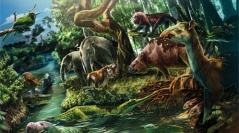

 Geodiversitas
45 (26) - Pages 739-767
Geodiversitas
45 (26) - Pages 739-767The La Venta deposits (Colombia) record one of the most fossil-rich regions in tropical South America and offers an exceptional opportunity to study the effect of the Miocene climatic changes and the evolution of extinct and extant clades in a low-latitude ecosystem. Land and freshwater vertebrates, and less commonly plants and invertebrates, constitute most of the La Venta fossils. The mammal record has been used to define the Laventan Age/Stage c. 13.5-11.8 million years old. La Venta has been studied for nearly a century, but the last major collecting efforts were done several decades ago. Recently, Colombian and international researchers have begun studies at La Venta, with the valuable participation of the local community. The joint efforts resulted in the establishment of a new La Venta natural history museum (Museo de Historia Natural La Tatacoa). This new wave of paleontological and geological studies has resulted in an improved stratigraphy of La Venta and new paleobiological and evolutionary hypotheses of several vertebrate groups, and in the museum’s educational and outreach activities. Here, we review the current geological and paleontological knowledge of La Venta, identify knowledge gaps, and discuss future research directions. A century after the first paleontological expedition, La Venta’s fossil record continues to illuminate the evolution of the South American tropical biodiversity during the Miocene.
South America, La Venta, tropics, paleobiology, geology, Miocene